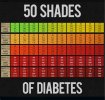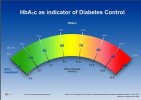I've been working to increase my knowledge of diabetes for a few years now, but a video I watched on YouTube leads me to believe there is something fundamental I don't understand. Here is the link to the video in case you'd like to see it:
The video is about doing your own A1c test at home. Here is what blew me away. I've had an A1c of 7 for the last few quarters at least. She says, that means my average glucose is 154mg/dl, or 8.4 mmol/L. Isn't A1c in mmol/L? If so, why is my personal measurement going to be higher than my A1c? I actually thought it would be the other way around. I'm very confused. Somebody, please help clarify this for me. thanks in advance.
The video is about doing your own A1c test at home. Here is what blew me away. I've had an A1c of 7 for the last few quarters at least. She says, that means my average glucose is 154mg/dl, or 8.4 mmol/L. Isn't A1c in mmol/L? If so, why is my personal measurement going to be higher than my A1c? I actually thought it would be the other way around. I'm very confused. Somebody, please help clarify this for me. thanks in advance.


